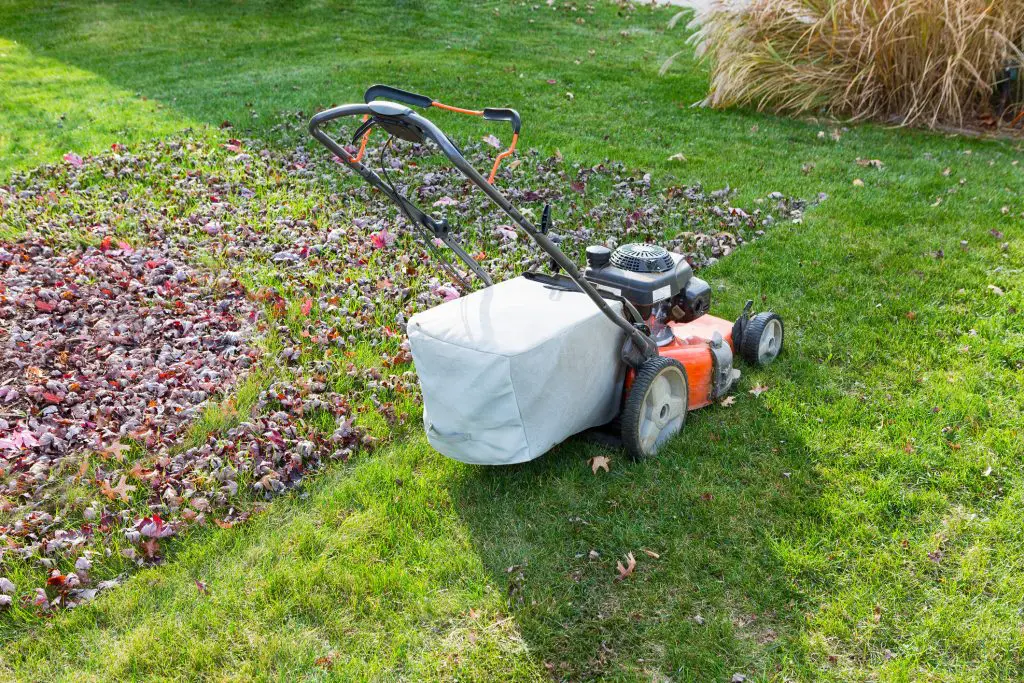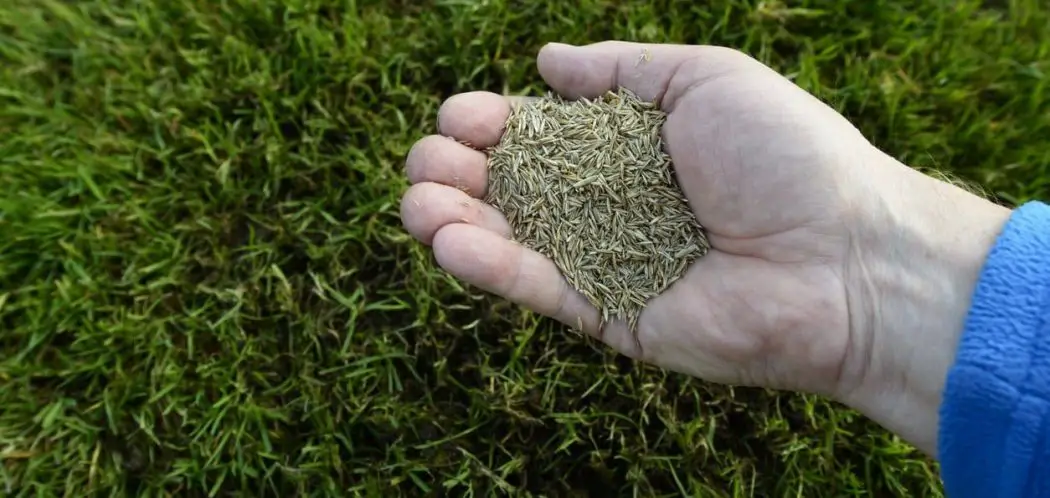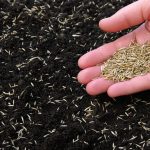If you’ve been distracted lately by the sight of your own lawn – and not in a good way, it may be time to do something about it. Seeding your lawn is always a good option for repairing patchy spots on your lawn, regrowing healthier grass, or simply adding more of it to your yard.
This can all easily be done by the process of seeding, or planting grass seeds in your lawn. Many people believe that you can only seed during the warmer months, but the truth is, seeding during the fall is just as effective.
However, it’s important to not only choose the right type of grass, but also make sure the season is right for planting. Certain grass grows better during particular seasons, which means if you try to plant a winter seed in the summer, it probably won’t grow successfully.
Given that it’s fall, it’s the perfect time of the year to seed cool-season grasses such as Kentucky bluegrass, perennial ryegrass, and tall fescue. Here, we’ve provided you with some fall cool season lawn seeding tips to make your seeding journey more successful.
Why Is Fall Ideal for Cool-Season Grasses?
Aside from the obvious, there’s a scientific reason why cool-season grasses grow better in the fall. For one, the soil still has warmth left from the previous summer months. That combined with the cool weather helps to speed up the germination process of the seeds.
You can easily find out whether or not temperatures are right for you to start seeding by simply purchasing a thermometer. I use this one (link to Amazon).
Seeds grow best when soil is anywhere between 50 to 65 degrees Fahrenheit, so all you have to do is test it with the thermometer.
Granted, the weather starts to cool down at different stages of the year in different parts of the country. This means that if you live up North, you’ll want to start planting as early as August. Those who live in warmer climates may be better off waiting until September or October.
You have a small window to plant seeds as you want to make sure your seeds have enough time to grow before the weather gets too cold. If not, you could risk killing them off.
Buying the Right Seeds
It’s imperative that you get the proper seeds to grow in this particular climate, so double check before you buy in bulk. As we mentioned earlier, certain seeds thrive in cooler weather and are better off planted in the fall, while others do better in the spring.
Get Your Soil Ready
The next step in seeding your lawn in the fall is to prepare your soil. You can do this by first removing anything that may get in the way of plant growth. This can be anything from stones, yard décor, rubble, and even larger pieces of wood that may be laying around.
Afterward, you want to air out your soil. You can do this by taking a rake and running it through your soil, making sure it gets in between one to two inches deep. Before you can drop your seeds in, you need to add seeding soil to the areas you are going to seed in.
Make sure that the soil you’re using already has fertilizer in it, or you’ll have to purchase that separately. Then you want to mix up all the soil and make sure your seeds have at least three inches to grow their roots in. Now, you’re ready to add your seeds.
Planting Your Seeds
Planting your seeds is harder than most people think it is. For one, you have to make sure you’re adding the right amount. Typically, you want to add about four to eight pounds of seed per 1,000 square feet of yard. Hopefully, you’ve already done the measuring. If you haven’t, now would be a good time to do so!
After you’ve figured out how much seed you want to lay down, you can go ahead and start to do so. Keep in mind that while you may want to plant as much as possible, planting too many seeds together will cause overcrowding and will stunt the growth of the grass. That’s why you need to make sure you’ve evenly spread them out. You also want an even spread so that your grass grows evenly.
Of course, if you’re simply trying to fill in patches or get an even amount of grass on your lawn, you can always over seed any thin areas. If this is the route you want to go, keep in mind that you should do it at least 45 days before the first snowfall or frost.
The more you overseed, the thicker your grass will grow in the spring. There is a balance to keep in mind here though, overseeding too much may cause grass to grow in clumps and not be evenly spread out.
Your Seeds Are Planted, Now What?
You may think you are done, but you’ve still got some work to do. Once you’ve successfully finished planting your seeds, you are going to need a lawn roller. Lawn rollers are essentially small steam rollers that you use to weigh down the seeds you’ve recently planted. This prevents not only erosion, but keeps animals from digging them up for an easy snack.
Fall can be known for its extra bouts of precipitation, so make sure you’re prepared for extra rainfall by having mulch or straw to add as a thin layer over the areas you’ve planted your grass seeds. This will keep the seeds from being washed away by the rain.
Many people might already know this, but keeping your growing seedlings hydrated is another helpful tip in making sure your lawn grows beautifully. You must make sure that the soil the grass is growing in stays as moist as possible, which means you have to water it consistently.
Watering can be tricky as you never know if you’re overwatering or underwatering. Ideally, you want to make sure the water seeps at least six to eight inches into the ground. As a result, you should water twice a day, ideally first thing in the morning and once later in the day. If it’s been a particularly dry season, however, you may want to water your seeds more often than that.
How Long Until I Start to See Results?
You may be eager to get results right away, but patience is a virtue. Typically, you will not start seeing any changes until about two weeks after you’ve planted your seeds. Grass shouldn’t take longer than two weeks to sprout, so if it has been any longer, you may want to consider reseeding again.
However, if you are successful and you start to see your seedlings pop up through the soil, you’ll want to continue watering as often as you were doing before.
If you’ve kept up with the same watering schedule, your grass should be ready to mow just a few weeks after sprouting. Once you decide to trim your yard, you don’t have to water as often.
Another thing to keep in mind is that although you might be tempted to, do not apply weed killer or any other harsh chemicals to your lawn until it’s been mowed at least twice.
Alternatives to Fall Seeding
If you’ve missed the mark and are feeling hopeless about growing a new lawn in time for spring, rest assured that there’s still hope. You can always go about dormant seeding your lawn instead.
Dormant seeding is when you plant your grass seed later in the fall season but before winter hits. You want the ground to be cold, but not too cold. Just enough to the point where the seeds that were planted won’t germinate until spring, when the soil starts to warm up again.
In this case, the type of seed you choose is also important. This is because you want to have a grass that will grow both in cool and warm weather, like the types of grass we named earlier. Kentucky bluegrass is ideal for growing in both conditions and would be a good choice in this case.
Dormant seeding is a lot like regular seeding in that you have to prepare the soil before you can plant the seeds. Again, make sure you loosen it up with a rake before placing the seeds in.
When normal seeding occurs, it’s vital to the survival of your seeds to water them as much as possible. When it comes to dormant seeding, however, you want to water your seeds less often. This is because other variables such as snow do the job for you, and you don’t want to drown your seeds if you’re watering on top of this.
The only time you should ignore this advice and water during the winter months is if it becomes unseasonably warm or dry.
Dormant seeding, while similar to regular seeding, does require less attention. That’s because you’re letting the elements do the work for you. While you normally don’t want to overseed your lawn, in the case of dormant seeding, it’s quite the opposite. Because they are growing in much harsher conditions, it’s likely not all seeds will survive. Having extra seeds means you’ll have more chances at having some survivors.
Fall Is a Good Time to Fertilize, Too
While the fall season may be ideal to plant certain grass seed, it’s also a great time to fertilize your lawn. The combination of warm soil and cool air makes for an ideal environment as it allows fertilizer to soak in longer and thus help you grow thicker and stronger roots in the long run.
The summer season brings warmth, which means more time spent playing outside. As a result, your lawn could suffer the consequences. You may have started to notice patches of grass missing or turning brown. This is likely caused by human foot traffic, pets, or spending additional time sitting in your yard.
Luckily, this is a simple fix. Start by loosening up the soil around the patches, like you would when you’re getting ready to plant grass seed. Then, apply a fertilizer to the area, and water.
Maintaining Healthy Grass During Fall
Now that you’ve managed to grow the grass of your dreams, your next task is to learn how to care for it. Fall can be an interesting time for plants. Some grow stronger than ever while others deteriorate. But like we mentioned earlier, getting grass suitable for your climate will ultimately be the key to having a healthy lawn.
Once fall comes around, there are a few things you should do to make sure you’re keeping your grass healthier than ever. First, start by making sure you’re clearing away any leaves that have fallen onto your yard. This is helpful because it blocks sunlight from your grass and traps moisture. As a result, your grass could end up growing fungus or drying out. Either way, neither option is good.
All throughout the fall you’re going to want to make sure you are removing any debris that happens to fall on your lawn. The easiest way to do this is with a rake or a leaf blower.
Take advantage of the cool weather by mowing the lawn as often as you can (without over-mowing of course). Your grass will continue to grow until the first snowfall hits so until then, keep your lawn mower out. The ideal height of grass should be anywhere between 2½ to 3 inches. The longer you let your grass grow, the more susceptible it is to fungus.
You may also want to continue aerating your soil during the fall months so as to prevent it from becoming blocked and covered in something known as thatch. Thatch is a layer of roots, sticks, and other debris that can form over your yard and can block sunlight, water, and other vital nutrients from getting to your grass.
Another important aspect of keeping a healthy lawn is to make sure you’re continuously weeding. Despite the weather being anything but ideal, weeds can still grow. That’s why it’s important to get as many weeds out of your lawn as possible before fall hits. That way, you’ll have one less thing to worry about.

Laying Sod During Fall
If you have decided against seeding this fall but you still want to clean up the unsightly patches in your lawn, you can always use sod. While sod may be more expensive than seeding, it is significantly less work and you get faster results.
Fall is a good time to put down sod because of the fact that there’s so much moisture in the air and the temperature is ideal. Caring for sod after you’ve laid it down is similar to the process of caring for newly seeded grass.
During the first two weeks of laying it down, you want to keep it moist, but not too moist. It’s important to keep a healthy watering schedule if you want to give your new sod a chance at survival. Remember, keeping the soil moist up to three inches is ideal.
Many people avoid laying down sod in the fall and winter months because they believe it simply won’t be successful. Not to mention sod will usually not spring up right away. However, it’s important to be patient with your sod – it will eventually flourish.
With seeds, it’s not necessary to water your lawn too often during the winter. But with sod, it’s important to keep it wet so it has a fighting chance at laying its roots down into your yard.
Remember that lawn roller we mentioned earlier? You’ll also need it when laying down your new sod. This is to help the roots stay in place while also making sure everything is planted where it’s supposed to be.
In Summary
There’s a common misconception people believe that says spring is the only time that plants can grow. But clearly, those people have never grown grass before. The truth is, grass thrives all year round, it’s just a matter of knowing what you’re doing. A real expert knows that grass can thrive during any season, if they know what they’re doing.
There are just a few simple things to keep in mind when seeding during the fall:
- Choose the right seeds for the right climate
- Aerate your soil before you plant
- Fertilize your soil
- Water it at least two times a day
- Let it grow a few inches before you mow it
- Keep any falling debris off your grass with a rake or a leaf blower
Caring for your lawn can be hard work, but with the right information, it should come easily. Besides, once you get the hang of it, you’ll be able to keep a perfect yard no matter what time of the year it is.
Now that you’ve got the proper knowledge, you’re ready to start planting the lawn of your dreams!





